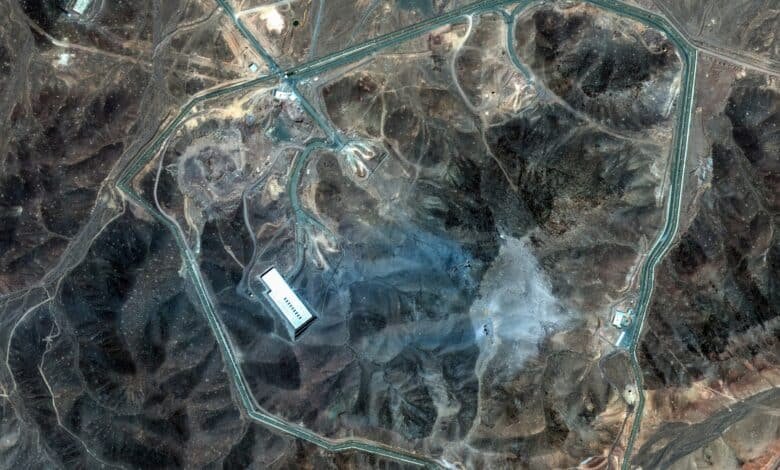Satellite images show a range of bombings in Iran’s nuclear sites

Following Midnight Hammer, the American operation to bombard the three main nuclear sites of Iran, some of the first views of the locations come from satellite images of the secret sites.
President Donald Trump said the three Iranian nuclear facilities reached by the US.
But others in the administration have been more circumspects, saying that an evaluation of damage on the battlefield should first be done.
“I know that the battle damage is of great interest. The final battle damage will take some time, but the initial battle damage evaluations indicate that the three sites suffered extremely severe damage and destruction,” said the president of the joint bosses on Sunday, Dan Caine, “This Week” on Sunday. “I think BDA is still pending and too early to comment on what may or may not be there.”
Several experts and officials have given their damage evaluations based on satellite images.
Ford nuclear site

This satellite image provided by Maxar Technologies shows damage to the enrichment installation of Fordo in Iran after US attacks on June 22, 2025.
Satellite image 2025 Maxar Technologies

This satellite image provided by Maxar Technologies shows a closer view of craters and ashes on a crest at the Fordo enrichment center in Iran after the US strikes. UU. On June 22, 2025.
Satellite image 2025 Maxar Technologies

This satellite image provided by Maxar Technologies shows a view close to the holes and craters on a crest in Fordo Enriqument facility in Iran after the US strikes. UU. On June 22, 2025.
Satellite image 2025 Maxar Technologies
“It is clear that ForDow was also directly affected, but the degree of damage within uranium enrichment rooms cannot be determined with certainty,” said the general director of the International Atomic Energy Agency Rafael Grossi In a statement On Sunday, after US bombs pointed to the most secret nuclear sites of the Iranians. Fordow is an alternative spelling for Fordo.
Fordo, about 60 miles south of Tehran, is built within a remote mountain complex and is considered the key site for Iran’s uranium enrichment research.
The satellite images point to the damage to Fordo in the form of several holes or craters of large diameter throughout the site. An extended blue ash layer on the installation also marks the impact of the strikes. In addition, several of the tunnel entries that lead to the underground installation seem to be blocked with soil.
“While there was uncertainty about whether the installation had been damaged by Israeli attacks, it is certainly damaged now,” Sam Lair, research associate at the James Martin center for non -proliferation studies of the Middlebury Institute, the Middlebury Institute, wrote in x.
“It seems that Fordo was beaten with at least six massive ordinance penetrators (Mops) given the six craters,” Lair told ABC News. “However, it is possible that, given the reports that perhaps 14 mops were used in the operation, that each crater hit twice to improve the depth of penetration, which means that up to 12 mops were used. This would be consistent with the relatively few MOP craters.”
From the position of the craters, experts believe that the attacks could have reached the ventilation axes of the installation.
“All this suggests that the installation has probably severely damaged. However, it is difficult to be sure until someone sees the interior,” Lair told ABC News.
The experts identified the blue/gray ashes visible throughout the site as an ejection of the MOP impacts. “It is certainly not a direct sign of radioactivity,” Professor Jacopo Buongiorno, from the Massachusetts Technology Institute.
“The only evidence of deep penetration is the amount of ejection produced by the mops, but we cannot say with certainty what was destroyed,” Decker Eveleth, CNA analyst, a non -profit organization based in Washington, wrote in x.
Finally, tunnel entries seem to be covered with ground. It is not clear if this was done by the Iranians to protect the installation or if it is the result of US strikes, experts say.

This satellite image shows a line of more than a dozen cargo trucks on an access road that leads to the fuel enrichment installation fordo in the underground complex entries on June 19 and 20.
2025 Maxar satellite image
“The United States may have tried to hit the tunnel tickets, but we also saw trucks and other heavy equipment that covered them with land two days ago. Therefore, it is not clear to me that the United States did or that matters,” Jeffrey Lewis of the James Martin center for non -proliferation studies wrote in x.
“Of these images and others, it seems that the tunnel entries and the construction of support on the site were not attacked, although the tickets had been partially buried by the Iranians in the day before the attack to help them protect them,” Lair told ABC News.
ISFAHAN Nuclear Technology Center

This satellite image provided by Maxar Technologies shows new damage of extensive buildings in the ISFAHAN facilities in Iran after US attacks on June 22, 2025.
Satellite image 2025 Maxar Technologies

This satellite image provided by Maxar Technologies shows new damage of extensive buildings in the ISFAHAN facilities in Iran after US attacks on June 22, 2025.
Satellite image 2025 Maxar Technologies

This satellite image provided by Maxar Technologies shows new damage of extensive buildings in the ISFAHAN facilities in Iran after US attacks on June 22, 2025.
Satellite image 2025 Maxar Technologies
The ISFAHAN Nuclear Technology Center in the center of Iran has new extensive damage in facilities buildings after the United States attack, with more than a dozen appearing totally destroyed, in addition to the four already affected by previous Israeli attacks.
“The last early attacks this morning damaged other buildings in Esfahan. In addition, we have established that the entrances to the underground tunnels on the site were affected,” Grossi said in a statement Sunday. Esfahan is an alternative spelling for Isfahan.
Much of the damage to the fuel plate plant on the north side was made the night from June 20 to 21 by the Israelis, the satellite images of before indicate.
However, the United States attack seems to have focused on the other part of the site, which is dedicated to uranium conversion, according to Dendamaging most of the buildings there.
Natanz Nuclear Installation

This satellite image provided by Maxar Technologies shows new extensive damage at Natanz’s facilities in Iran after US attacks on June 22, 2025.
Satellite image 2025 Maxar Technologies

This satellite image provided by Maxar Technologies shows new extensive damage at Natanz’s facilities in Iran after US attacks on June 22, 2025.
Satellite image 2025 Maxar Technologies
In Natanz, the largest Iranian nuclear enrichment center, an 18 -foot diameter hole directly on part of the underground military complex is visible in addition to the destruction of multiple buildings, according to Maxar, the satellite image service.
The buildings on Natanz’s floor had been strongly beaten by Israeli attacks during the first week of the offensive, damaging two buildings, the electrical infrastructure, the main building of the power supply, as well as the emergency and support generators, the OIEA had said.
The crater seems to show how the new attack focused on Natanz’s underground facilities. Similar to the crater in Fordo, experts told ABC News that believe that the presence of a great crater in Natanz shows that multiple taxi drivers were used in the installation that hits the same crater more than once, to improve the depth of penetration.





